
The lesser whistling duck, also known as Indian whistling duck or lesser whistling teal, is a species of whistling duck that breeds in the Indian subcontinent and Southeast Asia. They are nocturnal feeders that during the day may be found in flocks around lakes and wet paddy fields. They can perch on trees and sometimes build their nest in the hollow of a tree. This brown and long-necked duck has broad wings that are visible in flight and produces a loud two-note wheezy call. It has a chestnut rump, differentiating it from its larger relative, the fulvous whistling duck, which has a creamy white rump.

Cassia is a genus of flowering plants in the legume family, Fabaceae, and the subfamily Caesalpinioideae. Species are known commonly as cassias. The genus includes 37 species and has a pantropical distribution. Species of the genera Senna and Chamaecrista were previously included in Cassia. Cassia now generally includes the largest species of the legume subtribe Cassiinae, usually mid-sized to tall trees.

Root-knot nematodes are plant-parasitic nematodes from the genus Meloidogyne. They exist in soil in areas with hot climates or short winters. About 2000 plants worldwide are susceptible to infection by root-knot nematodes and they cause approximately 5% of global crop loss. Root-knot nematode larvae infect plant roots, causing the development of root-knot galls that drain the plant's photosynthate and nutrients. Infection of young plants may be lethal, while infection of mature plants causes decreased yield.

The Sunda pangolin, also known as the Malayan or Javan pangolin, is a species of pangolin.

Bischofia javanica, or bishop wood, is a plant species of the family Phyllanthaceae. It and the related Bischofia polycarpa are the only two members of genus Bischofia and tribe Bischofieae. These species are distributed throughout southern and southeast Asia to Australia and Polynesia also in North America. The tree is commonly used by tigers to scratch-mark territory in the jungles of Assam where it is locally called uriam. They also occur in southwestern, central, eastern, and southern China, and also Taiwan, where the indigenous people consider it a sacred tree.

Iresine is a genus of flowering plants in the family Amaranthaceae. It contains 20 to 25 species, all of which are native to the American tropics. The generic name is derived from the Greek word εριος (erios), meaning "wooly", referring to the trichome-covered flowers. Bloodleaf is a common name for those species that have colored foliage, and these are often cultivated as ornamental plants. Some species are additives to versions of the hallucinogenic drink ayahuasca.

Meloidogyne javanica is a species of plant-pathogenic nematodes. It is one of the tropical root-knot nematodes and a major agricultural pest in many countries. It has many hosts. Meloidogyne javanica reproduces by obligatory mitotic parthenogenesis (apomixis).
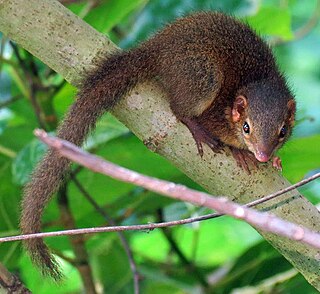
Horsfield's treeshrew, also called Javan treeshrew, is a treeshrew species within the Tupaiidae. It is endemic to the Indonesian islands of Sumatra, Bali, Java and Nias where it inhabits foremost primary forest.
Prunus javanica is a species of plant in the family Rosaceae. It is found in India, Indonesia, Malaysia, and Myanmar.
The Omoro Botanical Garden, also known as the Omoro Arboretum, is an arboretum and botanical garden located in the Ocean Expo Park, 424 Ishikawa, Motobu, Okinawa, Japan. It is open daily except Thursdays; admission is free.
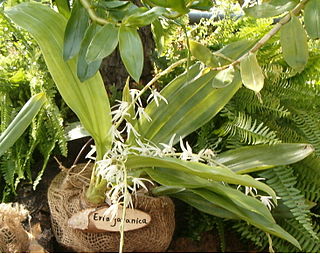
Eria is a genus of orchids with more than 50 species distributed in China, the Himalayas, the Indian Subcontinent, Southeast Asia, New Guinea, Polynesia, Melanesia and Micronesia.

Aerva javanica, the kapok bush or desert cotton, is a species of plant in the family Amaranthaceae. It has a native distribution incorporating much of Africa, and the south-west and south of Asia, and it has become adventitious in northern Australia.

Cryptochilus acuminatus, synonym Eria carinata, is a species of orchid. It is native to Nepal, Bhutan, Assam, Thailand, Vietnam and peninsular Malaysia.

Pinalia floribunda is a species of orchid found in Myanmar, Thailand, Vietnam, Malaysia, Indonesia and the Philippines in montane forests at elevations of 500 to 2400 meters above sea level. It is a small to medium-sized, warm-to-cold growing epiphyte found on large trees along streams. It has erect, stem-like, narrow ellipsoid pseudo-bulbs carrying soft leaves that flower in the spring.
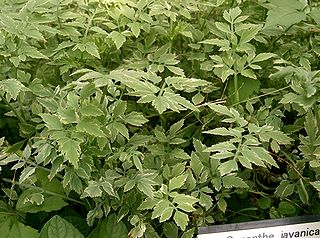
Oenanthe javanica, commonly Java waterdropwort, water celery, water dropwort, Chinese celery, Indian pennywort and Japanese parsley, is a plant of the genus Oenanthe originating from East Asia. It has a widespread native distribution in temperate Asia and tropical Asia, and is also native to Queensland, Australia.
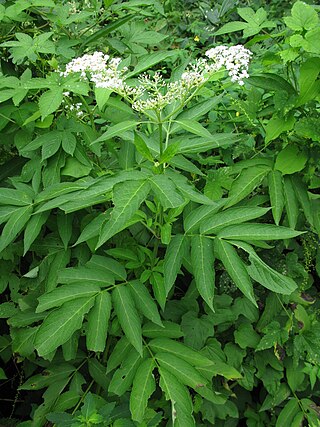
Sambucus javanica, the Chinese elder, is a species of elderberry in the family Viburnaceae native to subtropical and tropical Asia. It is found naturally in Bhutan, Burma, Cambodia, China, India, Indonesia, Japan, Laos, Malaysia, the Philippines, southern Thailand, and Vietnam. It is a perennial herb or a small shrub 1–2 m tall.

Cassia javanica, also known as Java cassia, pink shower, apple blossom tree and rainbow shower tree, is a species of tree in the family Fabaceae. Its origin is in Southeast Asia, but it has been extensively grown in tropical areas worldwide as a garden tree owing to its beautiful crimson and pink flower bunches.
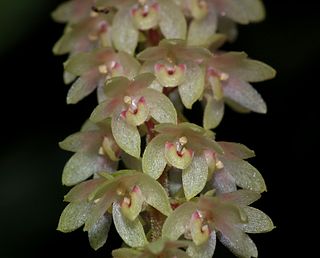
Pinalia polyura, or many-tailed pinalia, is a member of the orchid family endemic to the Philippines. It is semi-pendulous and sympodial, with pseudobulbs that are 20 cm long, 1 cm in diameter, and somewhat club shaped. Each new growth begins halfway along the previous year's pseudobulbs, making the plant longer each year. Each pseudobulb has about 5 shiny, lanceolate leaves approximately 15 cm long and 2 cm wide. Inflorescences appear at the upper portion of the plant and are pendulous, about 10 cm long and bear up to 40 flowers each 1.5 cm in diameter. It grows as an epiphyte and sometimes as a semi-terrestrial plant at elevations to 2,400 meters.

Phalaenopsis javanica is a species of orchid native to Java and Sumatra. The specific epithet javanica refers to the Indonesian island Java.
















